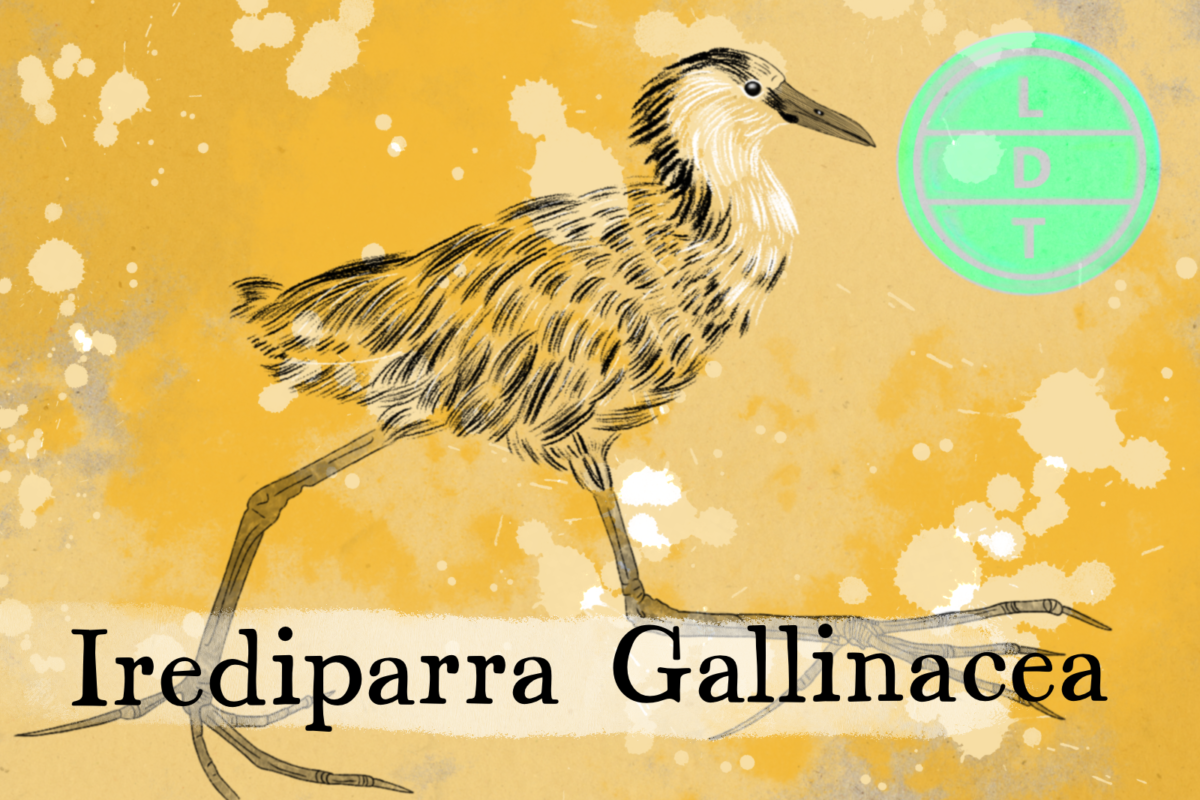“…and today we’re talking about the Big Foot of the outback. But more on that later.”
When you think of bigfoot, you’re probably imagining a large hairy ape, but the big foot of the Australian billabongs is not swamp ape. Instead, it’s a small graceful bird bouncing along the lily pads with water skis for feet. Finding a great place to eat is important for survival, and the jacana has chosen outback ponds as their preferred brunch spot. Adapting to your chosen habitat is essential to fine dining in Life, Death, and Taxonomy.
Description of the Jacana
- A chicken heron on stilts
- black crown and hindneck with a fleshy red wattle covering the forehead and forecrown,
- white face and throat.
- The comb is pinker in breeding adults, more orange when not breeding
- There is a broad black band on the lower breast with white belly.
- The underwing and flight feathers, which show most prominently in flight, are black.
- Back and upper wing mainly grey-brown with black primary coverts, rump and tail.
- The long legs with extremely long toes trail in flight.
- As a chick, it looks like a duck that Sid from Toy Story got a hold of
Measure Up
Welcome to the beloved Measure Up segment. The official listener’s favorite part of the show! The part of the show when we present the animal’s size and dimension in relatable terms through a quiz that’s fun for the whole family. It’s also the part of the show that’s introduced by you when you send in audio of yourself saying, singing, or chittering the words Measure Up into ldtaxonomy at gmail dot com. We don’t have a new Measure Up intro!
Length
- Females are larger at 24–27 cm (9.4–10.6 in)
- How many comb crested Jacanas go into the height of Big Foot, based on the most common physical descriptions in sightings?
- Hint: Of course, Big Foot is likely not a real animal, though there are a ton of believers out there. Honest sightings are likely misidentified upright animals, or people in fur clothing or costumes. The lack of evidence in light of modern technology is a problem for Sasquatch hunters, with most evidence being disproven or found to be intentional hoaxes. If there was a population so small for them to evade detection, they would run into genetic issues. For a species like Bigfoot to persist over time, there would need to be multiple specimens for breeding. Maintaining genetic diversity and avoiding inbreeding would be challenging for a small population.
- 10.19 birds. Sasquatch is said to be 9 feet tall.
Weight
- 120–150 g (4.2–5.3 oz)
- How many Jacana weights could a Victoria boliviana waterlily support before sinking?
- Hint: The Victoria boliviana, also known as the Bolivian waterlily, is the largest waterlily in the world. The leaves of Victoria boliviana can grow to an impressive width of around 3 meters (9 feet 10 inches).
- 531.32 birds. The lily pad is said to support the weight of a human up to 175 pounds.
Fast Facts about the Jacana
- Range: south-eastern Borneo, the southern Philippines, Sulawesi, Moluccas, Lesser Sunda Islands, north and south-east New Guinea, New Britain (Lake Lalili), and northern and eastern Australia.
- Diet: It eats seeds and aquatic insects gleaned from floating vegetation on the water’s surface.
- Behavior:
- In contrast to many bird and animal groups, many jacana species are not only matriarchal but also polyandrous, meaning that one female will maintain a harem of males
Major Fact: Big Foot Bird Bird
The comb-crested jacana thrives in habitats called billibongs, which are small bodies of freshwater in Australia. The term is often used to refer to an oxbow lake, which is a lake that is formed by river water that is left behind when the river changes course.
Billabongs are abundant floating vegetation, such as water-lilies or water hyacinth. Jacanas rely on these lakes to feed on waterbugs. Some birds might swim or hover over the water to catch insects, but not the jacana. Instead, they walk on the surface of the water, or rather on the vegetation.
To manage this, they have extremely strange looking elongated toes and toenails. Its elongated toes spread its weight across a lilypad or across several lily pads, in order to avoid sinking.
These adaptations enable it to forage for food and move gracefully across the water without sinking. However, gracefully is a strong word, because they kind of look like when you try to walk quickly on a trampoline.
Lily pads offer a surface to walk on, but they also attract insects, since they have little white flowers that stick up out of the water. Jacans often enjoy big fat Australian bees, which are slower than European bees and taste great to birds. Sometimes, they will pluck bees and other bugs right out of flowers, affording its prey a final meal.
Also, fathers are the ones to take care of their young and they do so by tucking them up under their wings while they walk around. It looks horrifying, because it appears as though one bird has a horrifying mass of spindly legs.
Females are larger and more aggressive, and she will kill young chicks to encourage the fathers to mate. Sometimes, these bullies will grab chicks right out from under their father’s wings.
Ending: So keep your harem happy, trot some lilies, and splash around on your oversized chicken stilts like the Jacana here in LDT.

